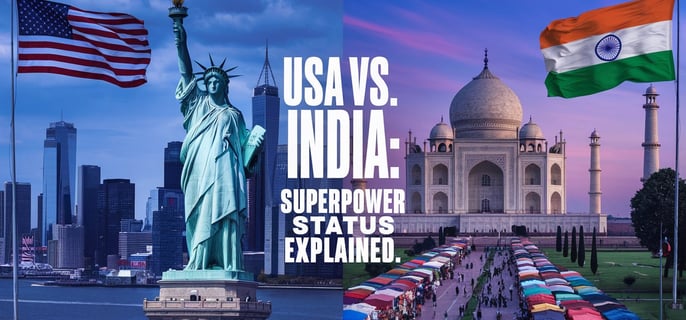India Cannot Be a Superpower Like the USA
Explore the challenges that prevent India from achieving superpower status like the USA in this insightful blog post. Delve into economic disparities, political stability, education, infrastructure, and civic responsibility, and discover what sets these two nations apart on their paths to global influence.
beingMJ
10/15/20243 min read


India is often seen as a rising power with the potential to become a global superpower. However, several key challenges and disparities prevent India from achieving a status comparable to that of the United States. This post examines these challenges using economic data, insights into income inequality, and civic responsibility.
1. Economic Disparities
GDP vs. GDP per Capita
As of 2023, India’s GDP is about $3.5 trillion, making it the fifth-largest economy in the world. However, its GDP per capita is only around $2,200, which is significantly lower than the U.S. GDP per capita of about $75,000. This difference indicates a large gap in living standards and economic opportunity.
Income Inequality
Income inequality is a major issue in India. According to the Global Inequality Report 2022, the top 10% of the population holds over 77% of the country’s wealth, while the bottom half owns just 4%. This uneven distribution of wealth limits economic mobility and creates social divides. In comparison, while the U.S. also faces inequality, its income distribution is more balanced.
2. Political Stability and Governance
Political Fragmentation
India’s political scene is characterized by many parties representing various regional, caste, and religious interests. This fragmentation often leads to unstable coalitions, making effective governance difficult. In contrast, the U.S. has a more unified political system, which allows for quicker decision-making.
Bureaucratic Challenges and Corruption
India ranks 85th out of 180 countries on Transparency International’s Corruption Perceptions Index 2022, indicating ongoing corruption in public offices. Bureaucratic inefficiencies can slow down important projects, whereas the U.S. has more mechanisms in place to ensure accountability and efficiency.
3. Infrastructure Issues
Transportation and Logistics
The World Economic Forum's Global Competitiveness Report shows that India ranks 70th out of 141 countries in infrastructure quality. Poor transportation networks increase logistics costs, estimated to be around 13-15% of India’s GDP—much higher than the 8-10% seen in developed countries like the U.S. This hampers economic growth and trade.
Energy Infrastructure
While India has made progress in expanding its energy capacity, about 20% of the population still lacks reliable electricity. The U.S. has a more diverse energy mix, investing significantly in renewable sources. India’s dependence on coal raises environmental concerns and complicates sustainable development.
4. Education and Skills Development
Quality of Education
Education is crucial for any nation’s progress. According to the National Achievement Survey, only 28% of Class 5 students in India can read at a basic level. In contrast, students in the U.S. generally perform better in international assessments like PISA, which emphasizes critical thinking and problem-solving skills.
Skill Mismatch
A report from the National Skill Development Corporation in 2022 indicated that about 40% of graduates in India lack employable skills. This mismatch contributes to a youth unemployment rate of approximately 23.5%, compared to 4.2% in the U.S. A skilled workforce is vital for competing in the global economy.
5. Military and Defense
Defense Spending and Capabilities
India’s military budget for 2023 is about $76 billion, making it the third-largest defense budget worldwide. However, India still lags behind the U.S., which spends around $877 billion. The U.S. military has access to advanced technology and a network of global alliances that enhance its capabilities.
Geopolitical Challenges
India faces complex geopolitical situations, particularly territorial disputes with China and Pakistan. These issues require significant military investment, diverting resources away from domestic development. The U.S., in contrast, benefits from a more stable geopolitical environment, allowing it to focus on global economic interests.
6. Civic Sense and Social Responsibility
Public Health and Sanitation
India's public health system faces significant hurdles. Nearly 70% of the population lacks access to basic healthcare services. In comparison, the U.S. spends about $11,000 per capita on healthcare, resulting in better health outcomes. A strong sense of civic responsibility regarding health and sanitation is crucial for societal well-being.
Environmental Awareness
India struggles with severe environmental issues, including air and water pollution. The World Health Organization notes that 14 of the world's 15 most polluted cities are in India. While initiatives are underway to address these problems, greater public awareness and action are needed. The U.S. has more established practices for environmental responsibility, contributing to a higher quality of life.
Conclusion
While India has significant potential and is experiencing considerable growth, several challenges hinder its ability to achieve superpower status like that of the United States. Addressing economic disparities, improving governance, investing in infrastructure and education, and fostering a sense of civic responsibility are all essential steps for India’s aspirations.
India's path may differ from that of the U.S., but with focused reforms and strategic planning, it can carve out its unique role in the global landscape. The journey ahead is challenging, but the opportunities for change are substantial.
Contact Us :
beingaimj@gmail.com
© 2024. All rights reserved.
